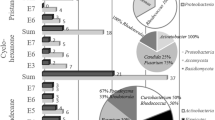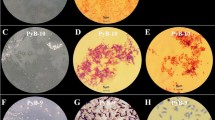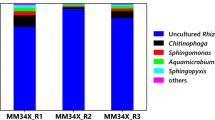Sixteen environmental samples, from the United States, Germany and Norway, with histories of previous exposure to either creosote, diesel fuel or coal tar materials, were screened for bacteria which could degrade high molecular weight (HMW) polycyclic aromatic hydrocarbons (PAHs). A modified version of the spray plate technique was used for the isolations. Using fluoranthene (FLA) and pyrene (PYR) as model HMW PAHs, we isolated 28 strains on FLA and 21 strains on PYR. FLA degraders were defined as able to grow on FLA but not PYR. PYR degraders grew on both PAHs. All PYR degraders were found to be Gram-positive and all FLA degraders were Gram-negative. GC-FAME analysis showed that many of the PYR degraders were Mycobacterium spp and many of the FLA degraders were Sphingomonas spp. Comparison of the metabolic characteristics of the strains using the spray plate technique and direct growth studies revealed that more than half of the FLA degraders (59%) were able to cometabolize PYR (ie, they produced clearing zones or colored metabolites on spray plates but did not grow on the PAH) and the ability of many of these strains to cometabolize fluorene, anthracene, benzo[b]fluorene, benzo[a]anthracene and benzo[a]pyrene was significantly affected by pre-exposure to phenanthrene. Studies on the metabolic products produced from PYR cometabolism by strain EPA 505 suggested the possibility of attack at two different sites on the PYR molecule. However, the inability to derive degradable carbon from initial opening of one of the PYR rings probably accounted for the lack of growth on this PAH by the FLA-degrading strains. The PYR degraders on the other hand, were less able to cometabolize HMW PAHs, even following pre-exposure to PHE. Characterization of the FLA degradation pathway for several of the Sphingomonas isolates indicated oxidation and ring opening through to acenaphthenone as the principle metabolite. Strain CO6, however, also oxidized FLA through fluorenone, suggesting a dual attack on the FLA molecule, similar to that observed by others in Mycobacterium spp. Journal of Industrial Microbiology & Biotechnology (2000) 24, 100–112.
Similar content being viewed by others
Author information
Authors and Affiliations
Additional information
Received 01 May 1999/ Accepted in revised form 01 November 1999
Rights and permissions
About this article
Cite this article
Ho, Y., Jackson, M., Yang, Y. et al. Characterization of fluoranthene- and pyrene-degrading bacteria isolated from PAH-contaminated soils and sediments. J Ind Microbiol Biotech 24, 100–112 (2000). https://doi.org/10.1038/sj.jim.2900774
Issue Date:
DOI: https://doi.org/10.1038/sj.jim.2900774




